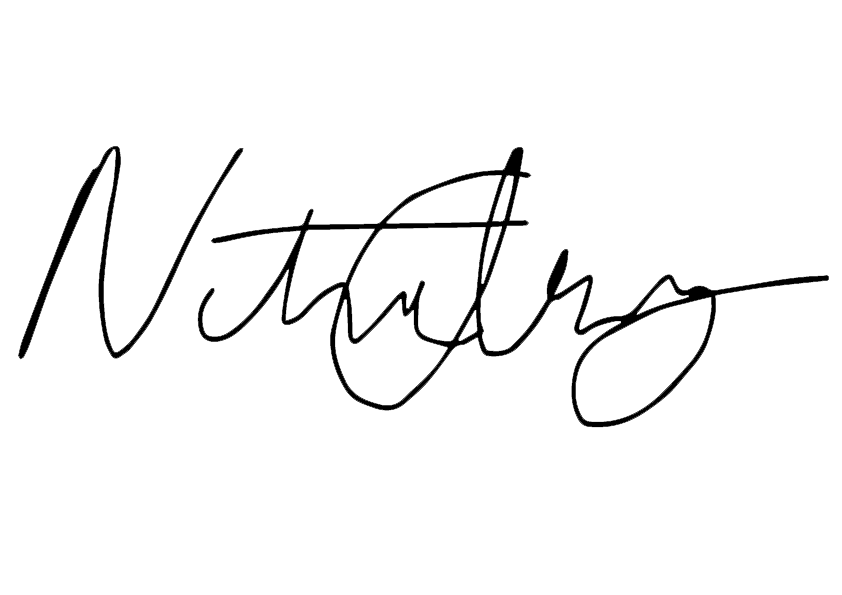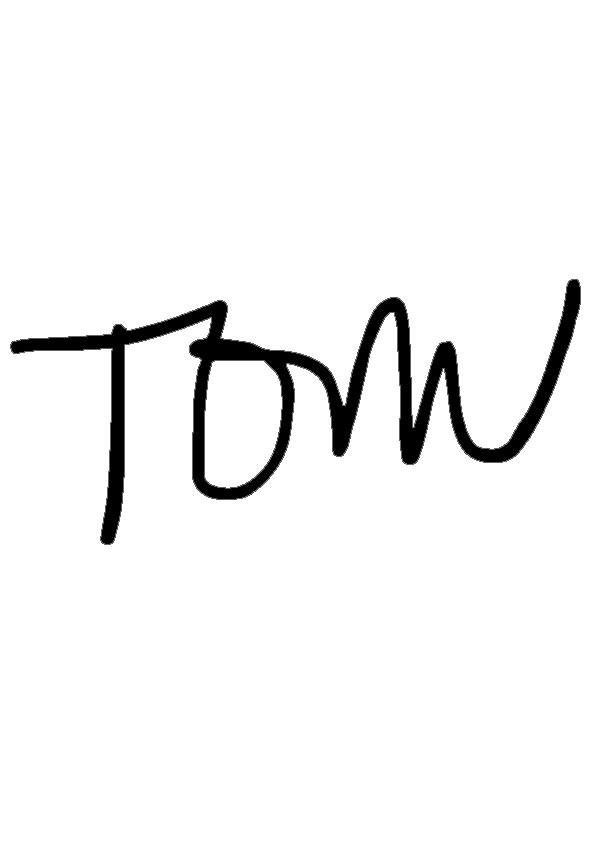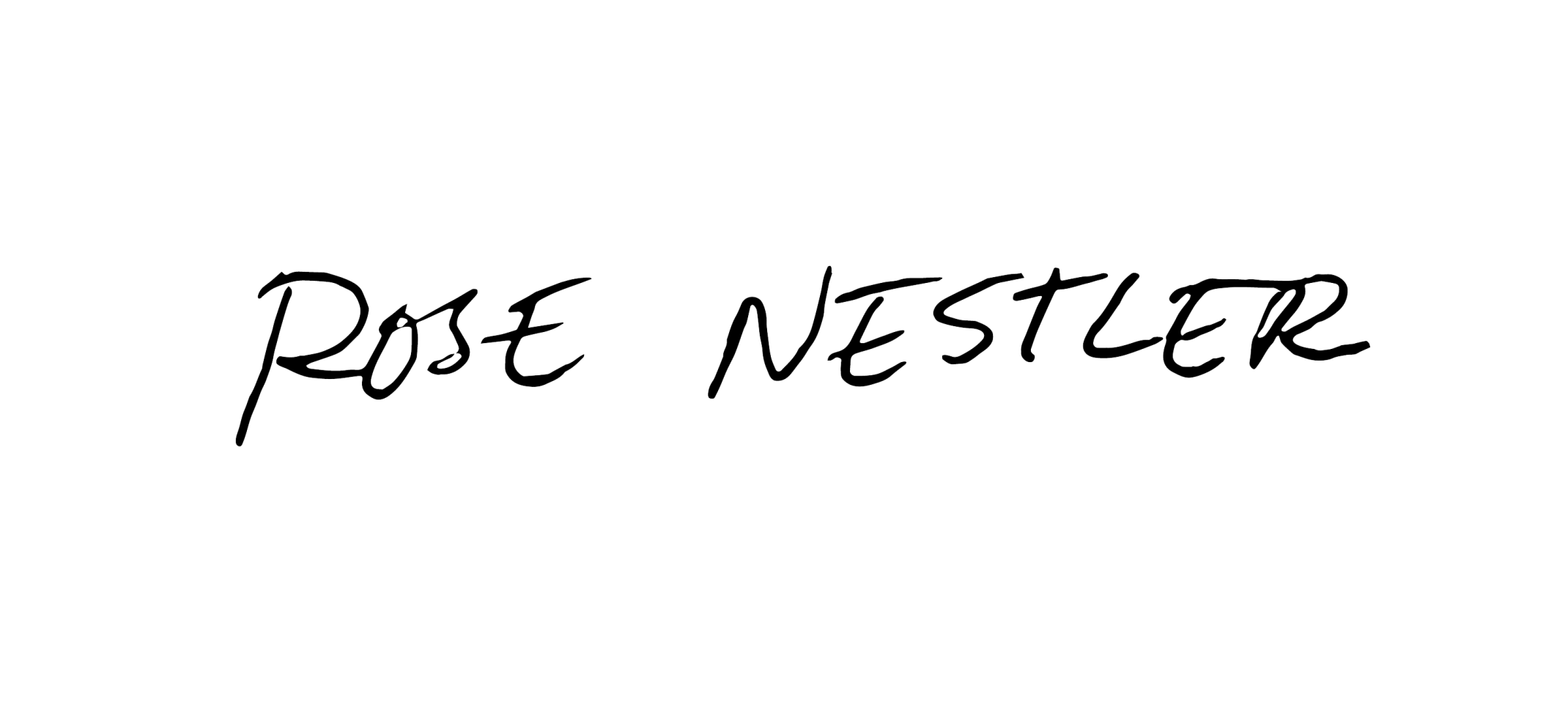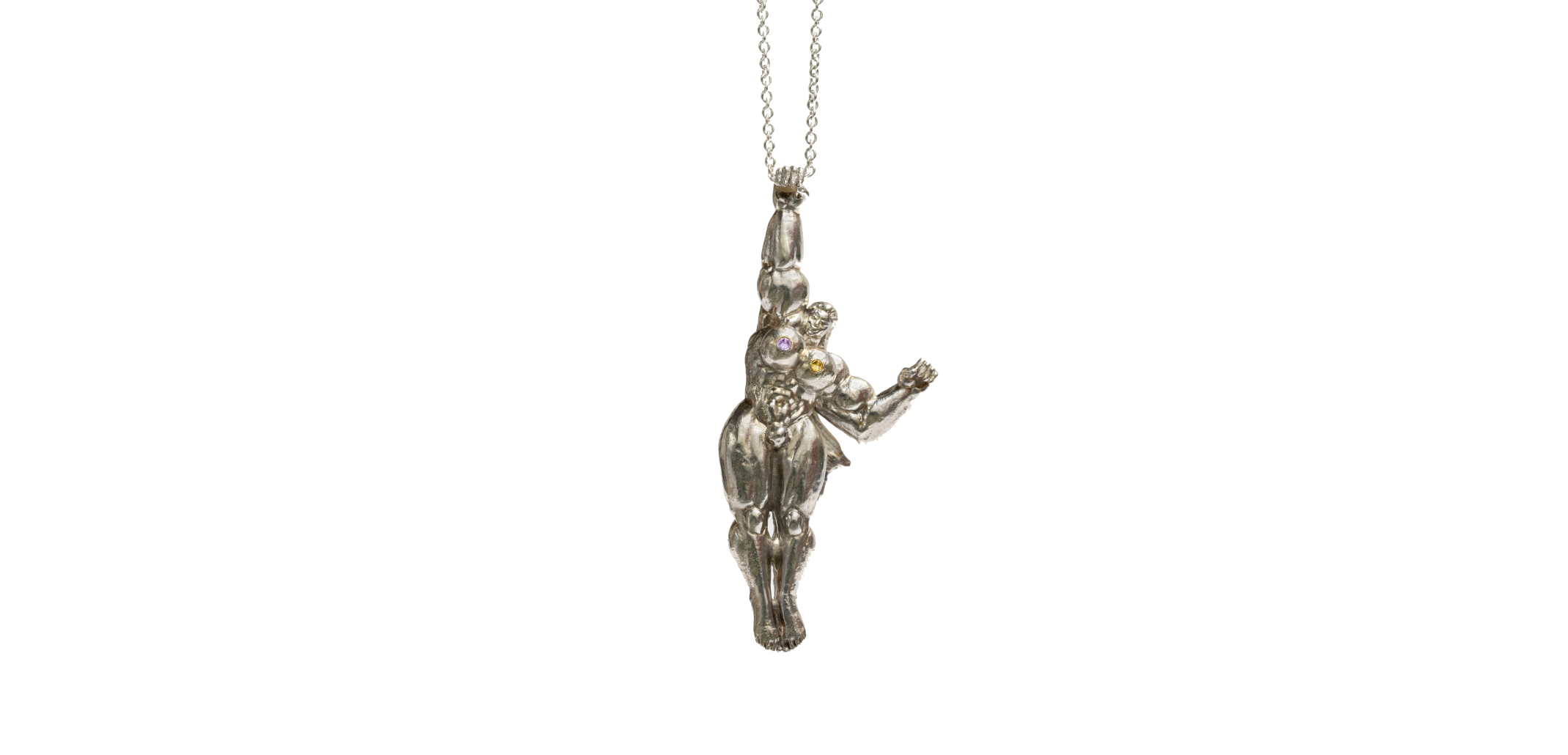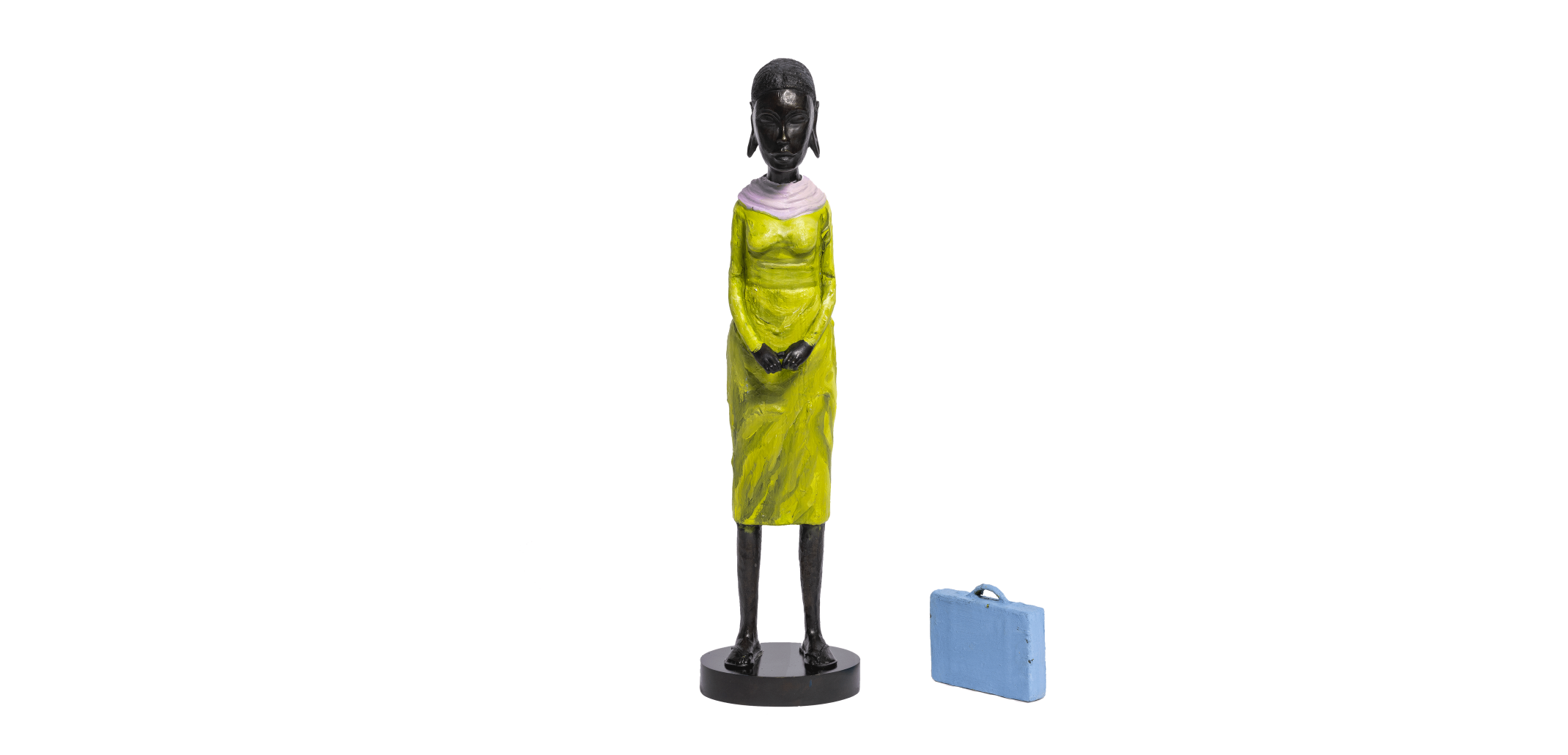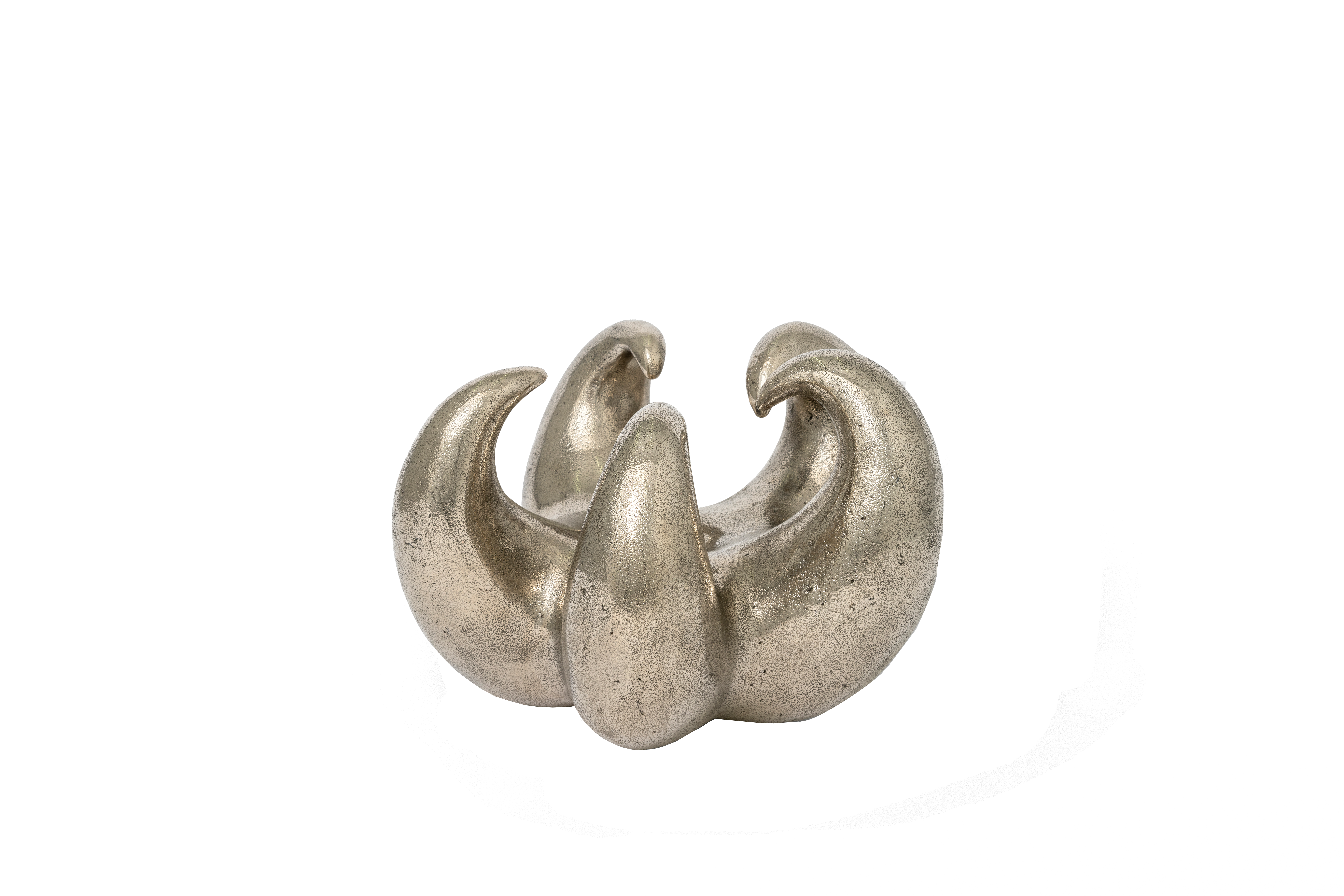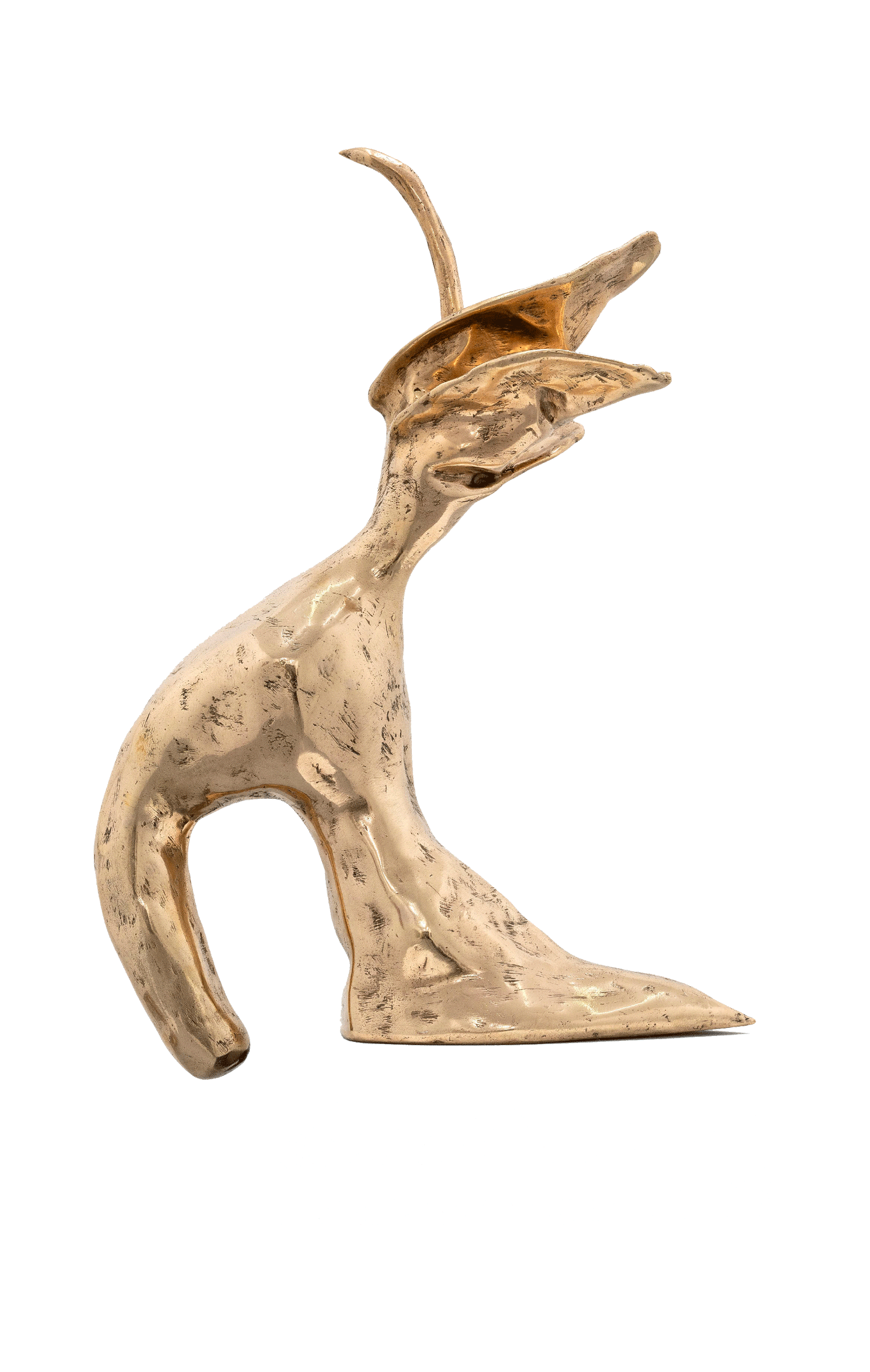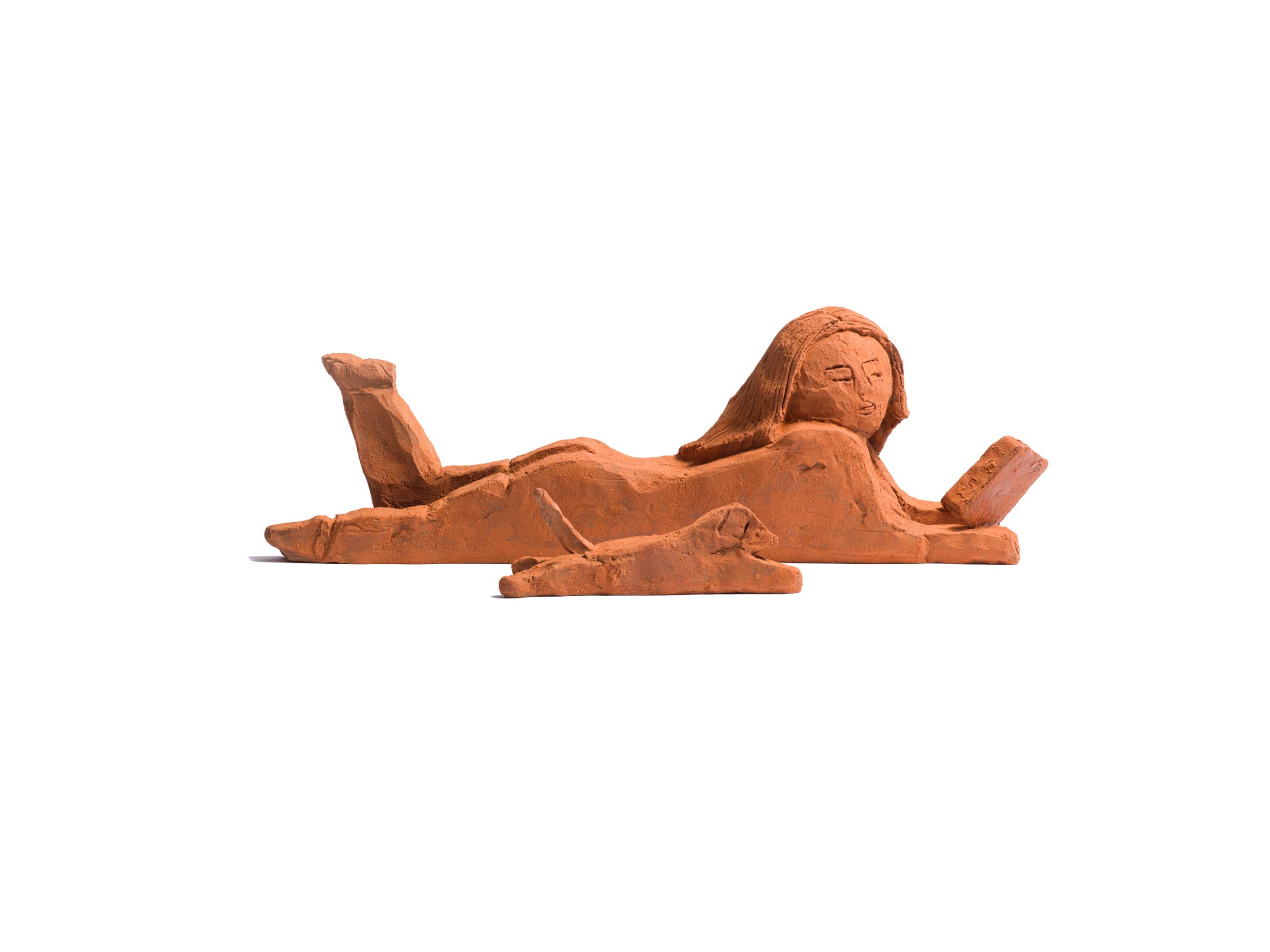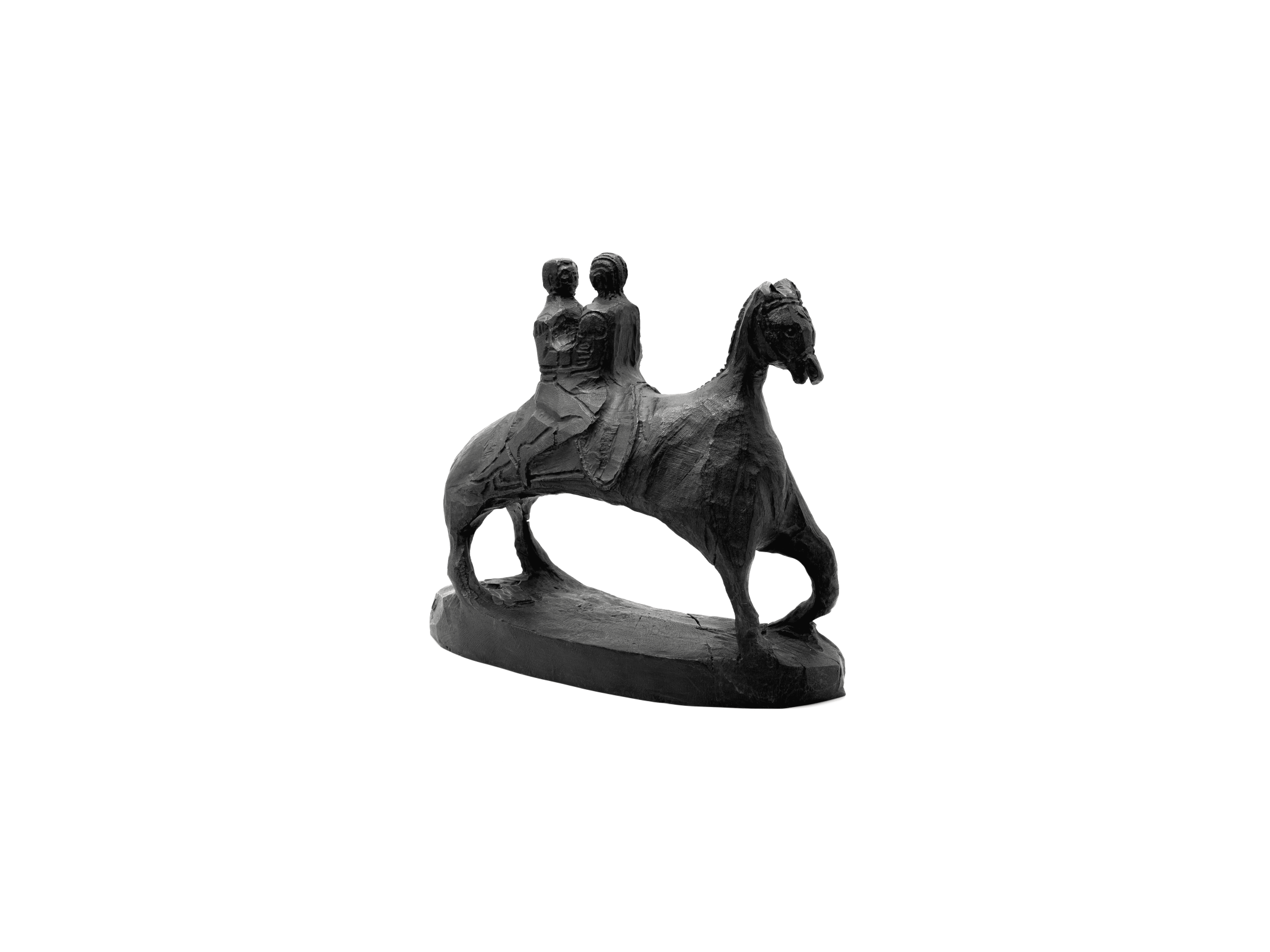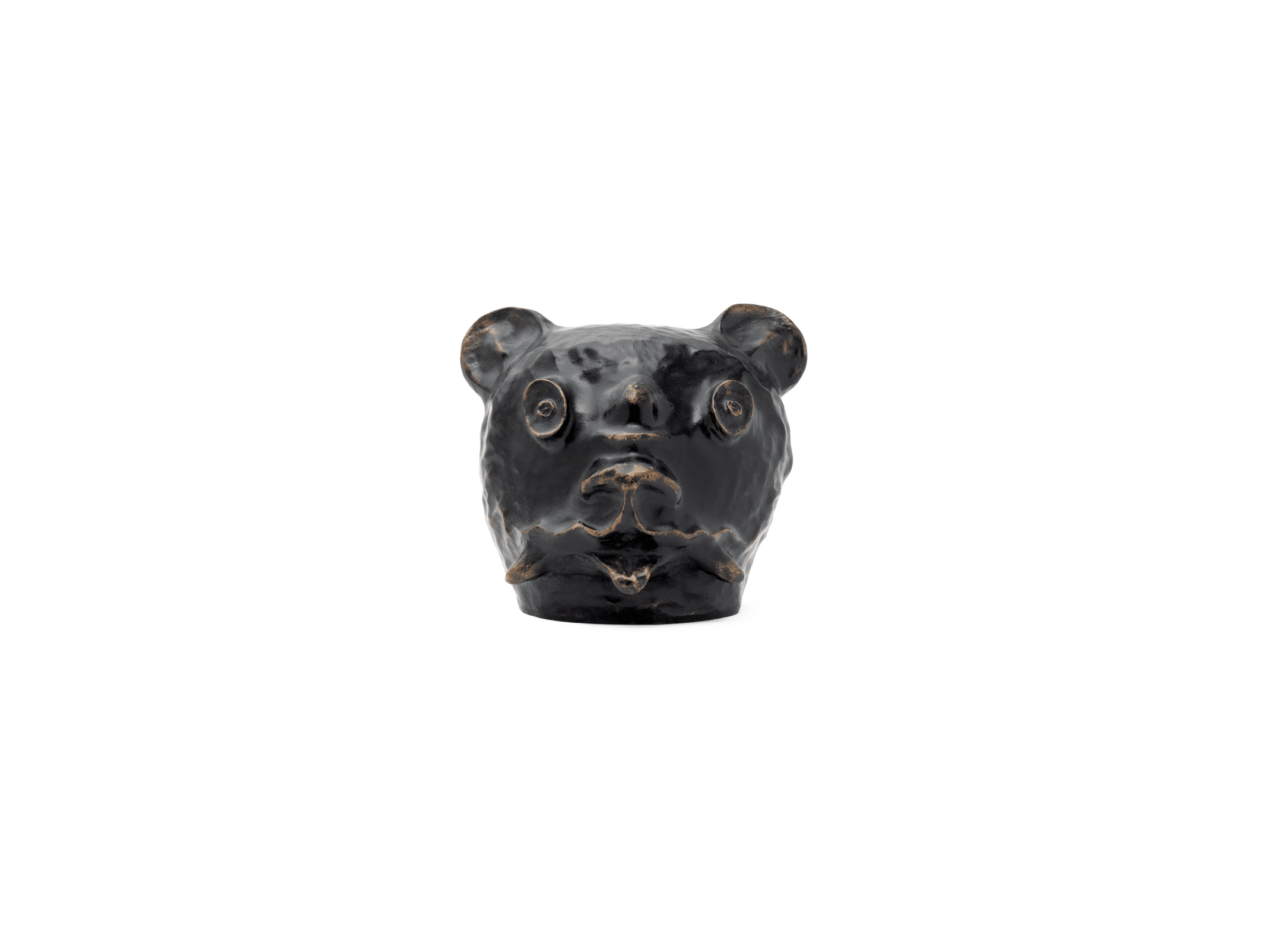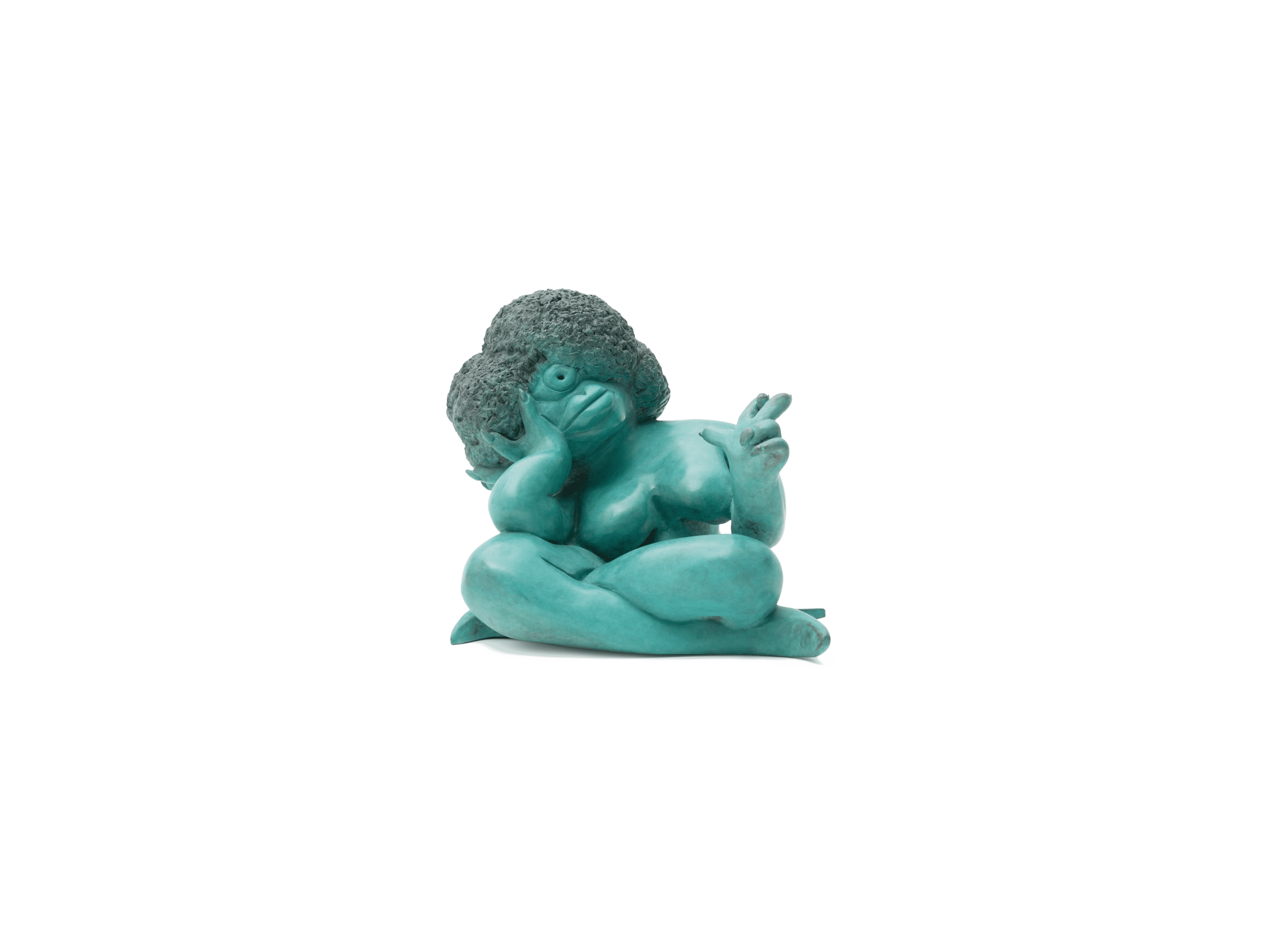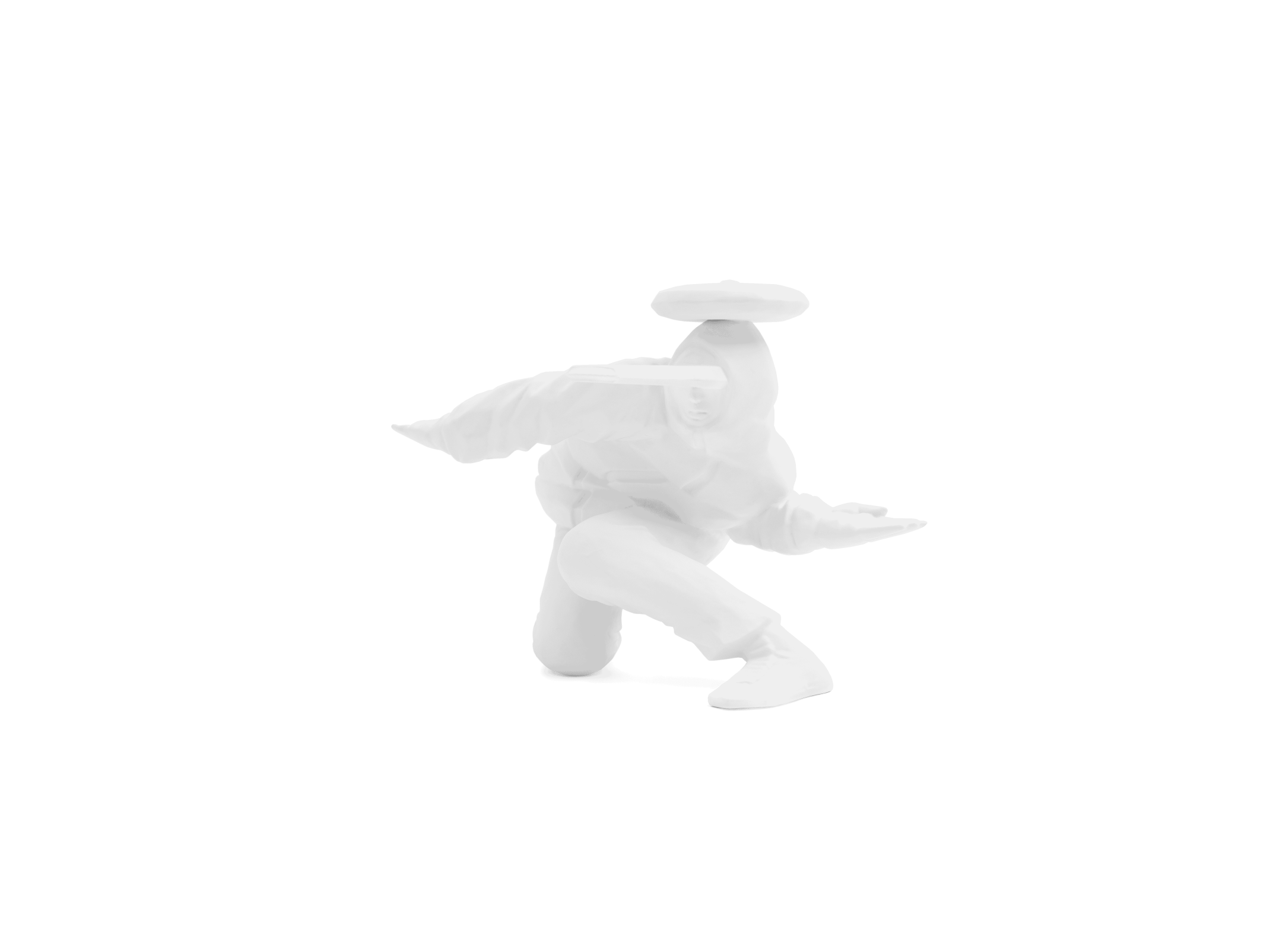Michael Swaney is a Canadian artist, born in Kimberley in 1978. He currently lives and works in Barcelona (Spain). Swaney defends an access to simple, inclusive and non-elitist art, drawing his references from popular culture, daily life and his childhood. We find in his works his fascination for the spontaneity of Art Brut and “outsiders”. Searching for random, he approaches his creations in a direct and intuitive way, enjoying painting where his hands guide him. Michael Swaney develops through his creative impetus, an ethic of accessibility of the artistic gesture, carried by the universality of his themes and forms. He regularly invites the public to participate in his projects.
-
2023
TBA, Piermarq, Sydney, Australia
-
2023
“Jardín de Luz”, Delimbo, Seville, Spain
-
2022
“4 Hands”, Steve Turner, Los Angeles, United States
-
2022
“How many paintings in a roll of canvas?”, Nbb Gallery, Berlin, Germany
-
2021
“Finger Family”, Allouche Benias Gallery, Athens, Greece
-
2021
“Torrential Avalanche Sandwich”, Breach, Miami, United States
-
2019
“Peanut Butter & Honey Moon”, Sorry We’re Closed, Brussels, Belgium
-
2018
“Here I am, here I am, how do you do?”, L21 Gallery, Mallorca, Spain
-
2017
“Ongange Lellow”, Gnyp Gallery, Berlin, Germany
-
2016
“Papisho”, Charlotte Fogh Gallery, Aarhus, Denmark
-
2015
“Physiology of Taste”, Rafael Pérez Hernando, Madrid, Spain
-
2015
“Sculptures & Groceries”, Louis 21, The Envelope, Mallorca, Spain
-
2014
“Subtropics”, Krets, Malmö, Sweden
-
2014
“Hut 1 Paintings 4”, Blokker, Madrid, Spain
-
2013
“Sleeping Beauty Painter”, Charlotte Fogh Gallery, Aarhus, Denmark
-
2013
“You just got blogged”, me & the curiosity, Barcelona, Spain
-
2013
“:•)”, noestudio, Madrid, Spain
-
2012
“Efecto Dubuffet”, Mulherin + Pollard, New York, United States
-
2012
“Go West”, Escala, Valencia, Spain
-
2011
“Ding Dong”, Alice Gallery, Brussels, Belgium
-
2011
“Ancient Scrolls”, Diana Lowenstein Fine Arts, Miami, United States
-
2023
“Meeting Point”, Galerie Slika, Lyon, France
-
2022
“Plays Well With Others”, Freight + Volume Gallery, New York, United States
-
2022
Summershow, Piermarq*, Surry Hills, Australia
-
2022
“Familiar Faces”, curated by Raymond Lemstra, Mini Galerie, Rotterdam, Netherlands
-
2020
“The Edge of Chaos”, The Newsstand Project, Los Angeles, United States
-
2018
“3 Person Show”, Ever Gold Projects, San Francisco, United States
-
2018
“As If A Field Could Become Some Dream”, No Place, Columbus, Ohio, United States
-
2018
“Velvet Ropes GIFC”, David Risley Gallery, Copenhagen, Denmark
-
2017
“In Paper We Trust”, The Dot Project, London, curated by Sara Clarken & Brigitte Mulholland, United Kingdom
-
2017
“Three-way Ticket”, Needles And Pens, San Francisco, curated by Pablo de Pinho 21, Left Field, Gallery, San Luis Obispo, United States
-
2016
“Grand Opening Show”, Allouche Gallery, New York, United States
-
2016
“Itch Under The Skin”, Charlotte Fogh Gallery, Aarhus, Denmark
-
2016
“Christmas Show”, Versace Versace Versace, Miami, United States
-
2015
“Second Show”, Eddys Room Gallery, New York, United States
-
2015
“Art Copenhagen”, Charlotte Fogh Gallery, Denmark
-
2020
“Hamsa Finger Family”, bronze sculpture, Bomma, France
-
2016
Some Songs with Ariadna Serrahima, IF Publications, Barcelona
-
2016
Jugs & Mugs, Bronze Age Editions, London
-
2013
758 Likes, Museums Press, Glasgow
-
2013
YJGB, me & the curiosity, Barcelon
-
2012
Bell Face, Nieves, Zurich
-
2012
Fun!, Exhibition catalogue, Riihimäki Art Museum, Riihimäki
-
2012
Go West, Exhibition zine by Escala, Valencia
-
2012
An After Noon With Picasso, with Arvo Leo, Td Papeles, Barcelona
-
2011
Carletes zine with Antonio Ladrillo, Trineo Editions, Toledo
-
2011
Platonique Revue d’images #7
-
2011
Fortune Bookie with Antonio Ladrillo, Éditions du Livre
-
2011
1 Snake, Td Papeles, Barcelona
-
2010
The Corner (exhibition catalogue), Galeria Victor Saavedra, Barcelona
-
2010
Guasch Coranty International Paint Prize (exhibition catalogue), Barcelona

“Here I am, here I am. How do you do?”, 2018, exhibition view, L21 Gallery, Mallorca, photos © Natasha Lebedeva, courtesy of L21 Gallery and Michael Swaney
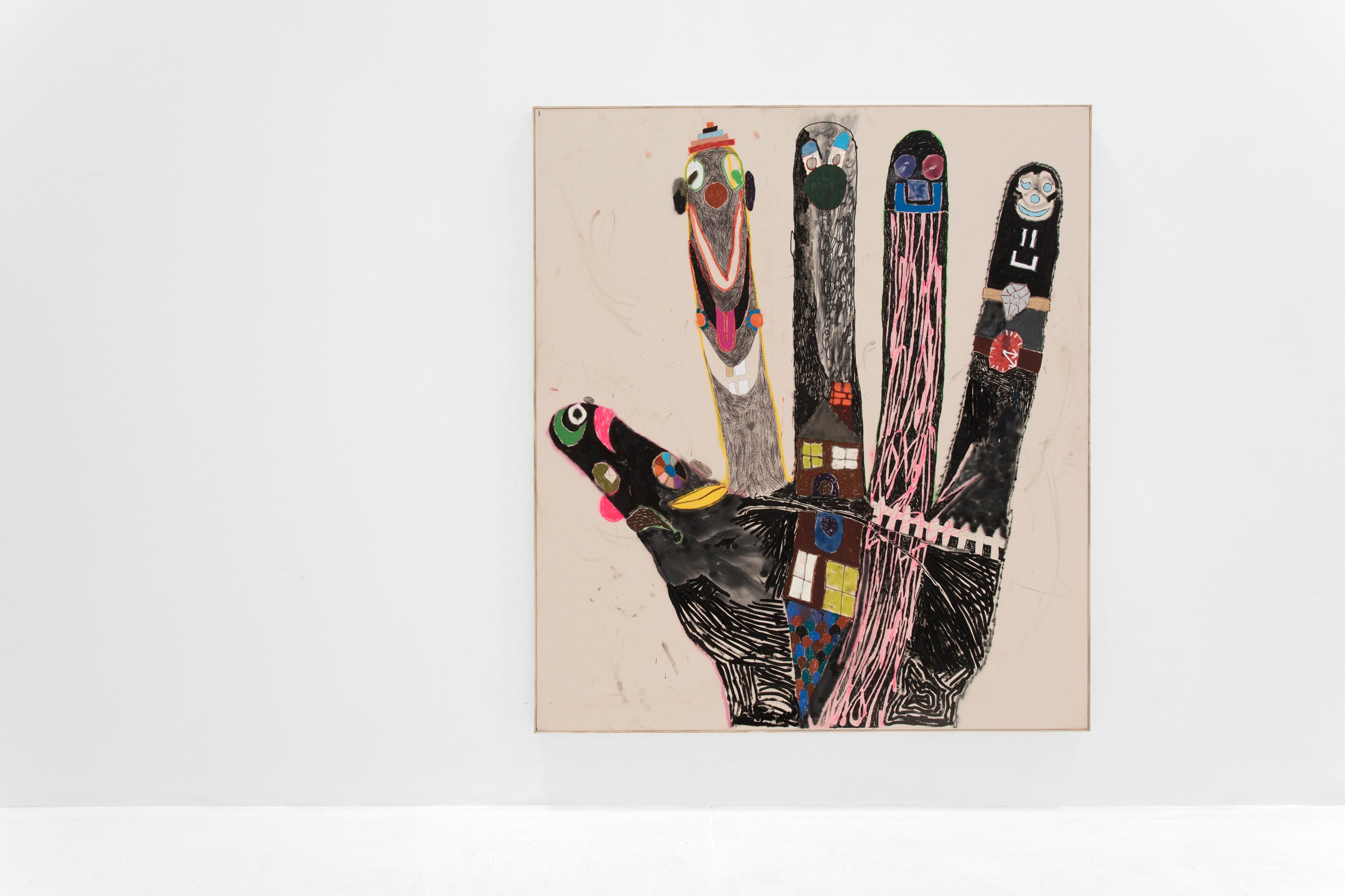
Finger Family (9th Hand), 2018, acrylic, spray paint, oil bar and oil pastel on canvas, 190 × 170 cm, photos © Natasha Lebedeva, courtesy of L21 Gallery and Michael Swaney
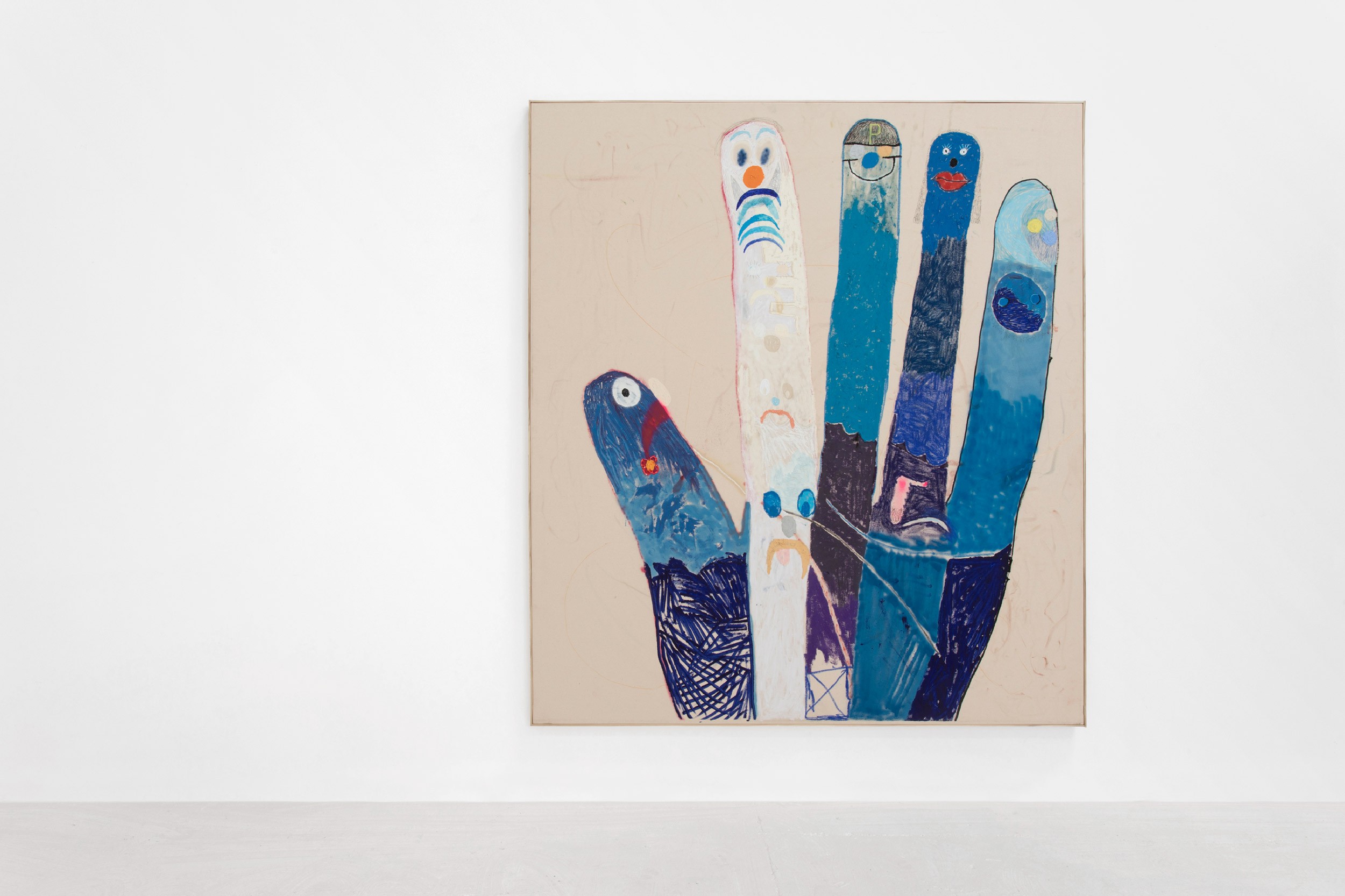
Finger Family (4th Hand), 2018, acrylic, spray paint, oil bar and oil pastel on canvas, 190 × 170 cm, photos © Natasha Lebedeva, courtesy of L21 Gallery and Michael Swaney
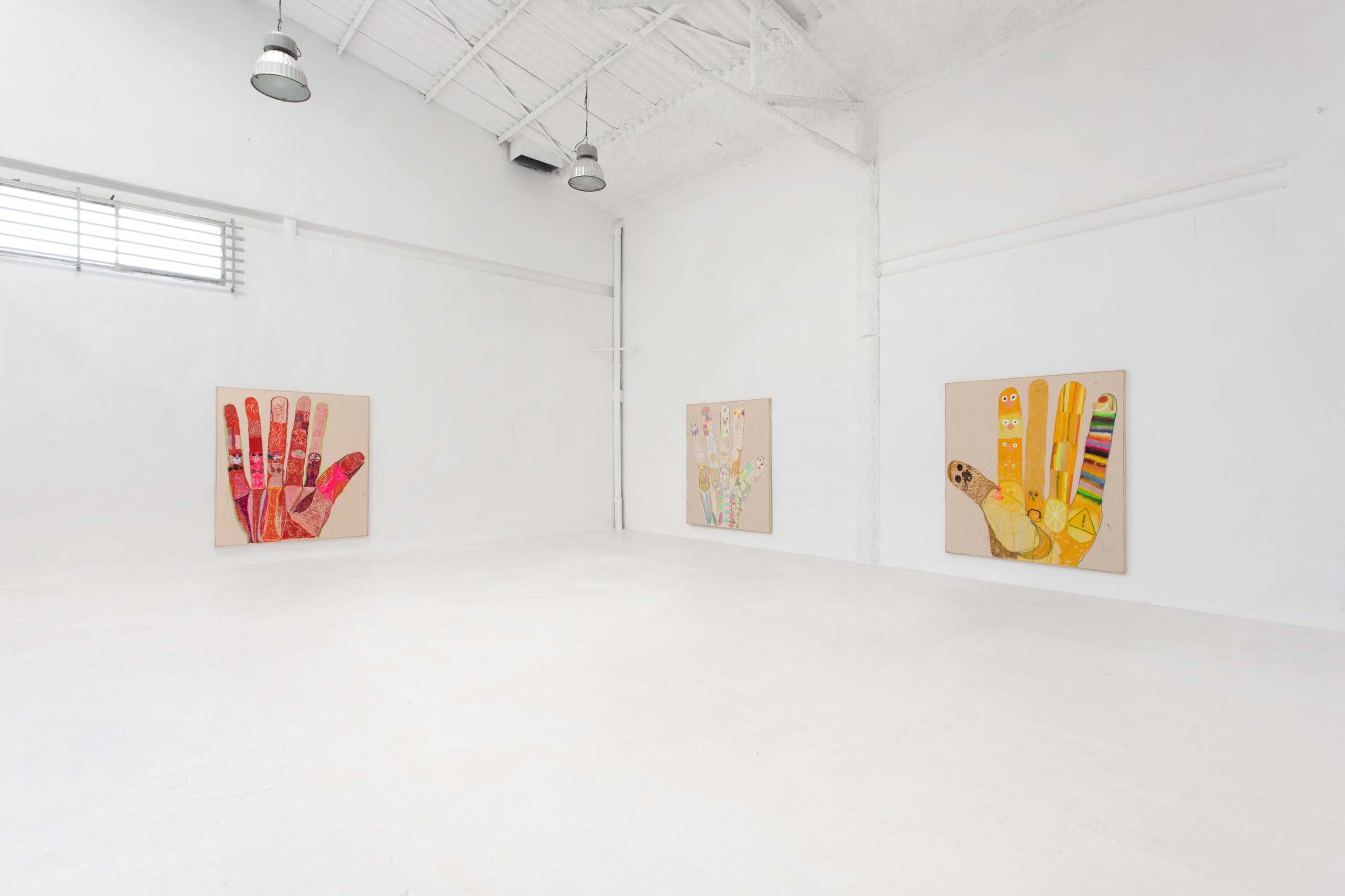
“Here I am, here I am. How do you do?”, 2018, exhibition view, L21 Gallery, Mallorca, photos © Natasha Lebedeva, courtesy of L21 Gallery and Michael Swaney

Finger Family (10th Hand), 2018, acrylic, spray paint, oil bar and oil pastel on canvas, 190 × 170 cm, photos: © Natasha Lebedeva, courtesy of L21 Gallery and Michael Swaney
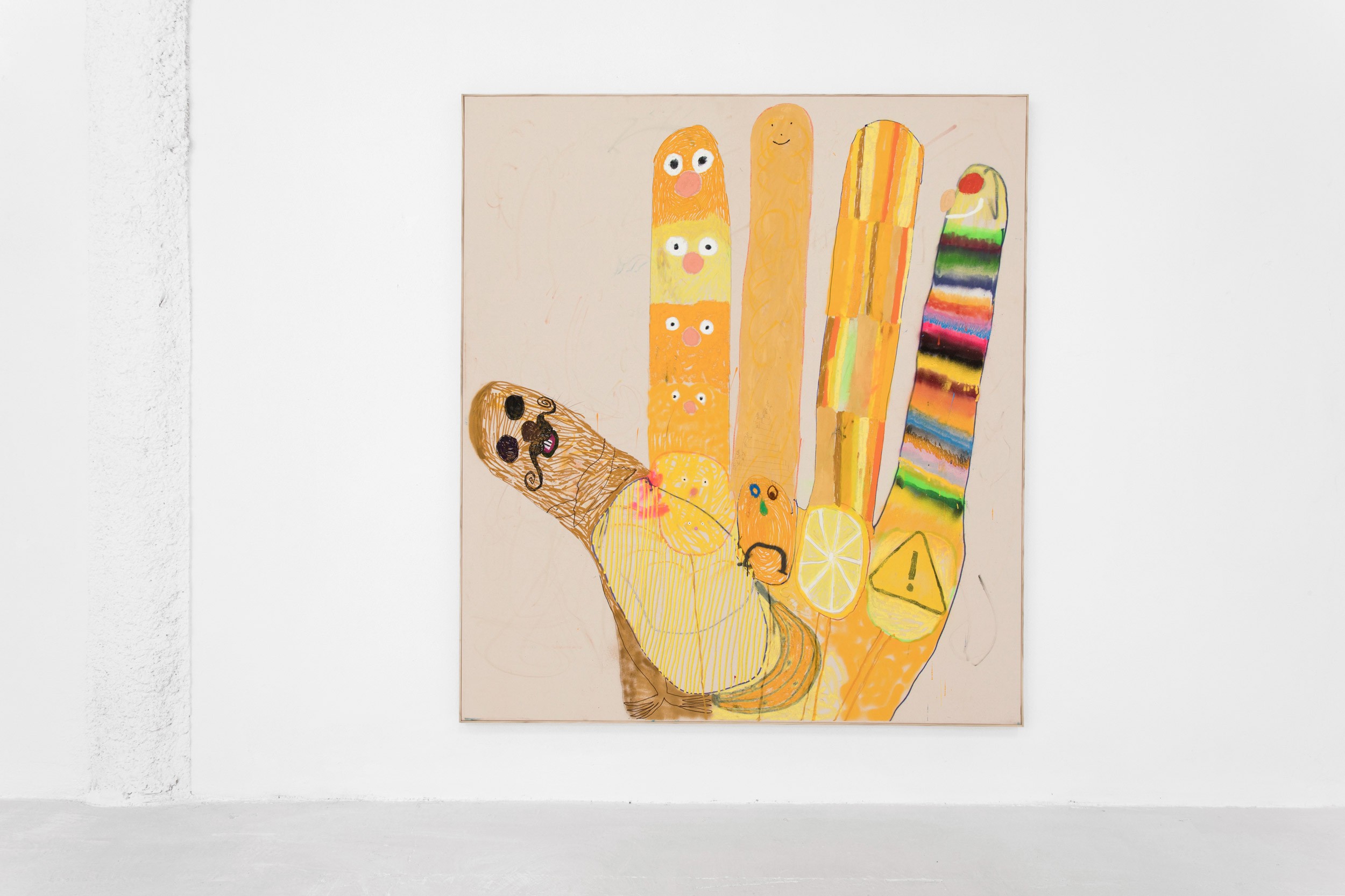
Finger Family (11th Hand), 2018, acrylic, spray paint, oil bar and oil pastel on canvas, 190 × 170 cm, photos © Natasha Lebedeva, courtesy of L21 Gallery and Michael Swaney

Finger Family (12th Hand), 2018, acrylic, spray paint, oil bar and oil pastel on canvas, 190 × 170 cm, photos © Natasha Lebedeva, courtesy of L21 Gallery and Michael Swaney
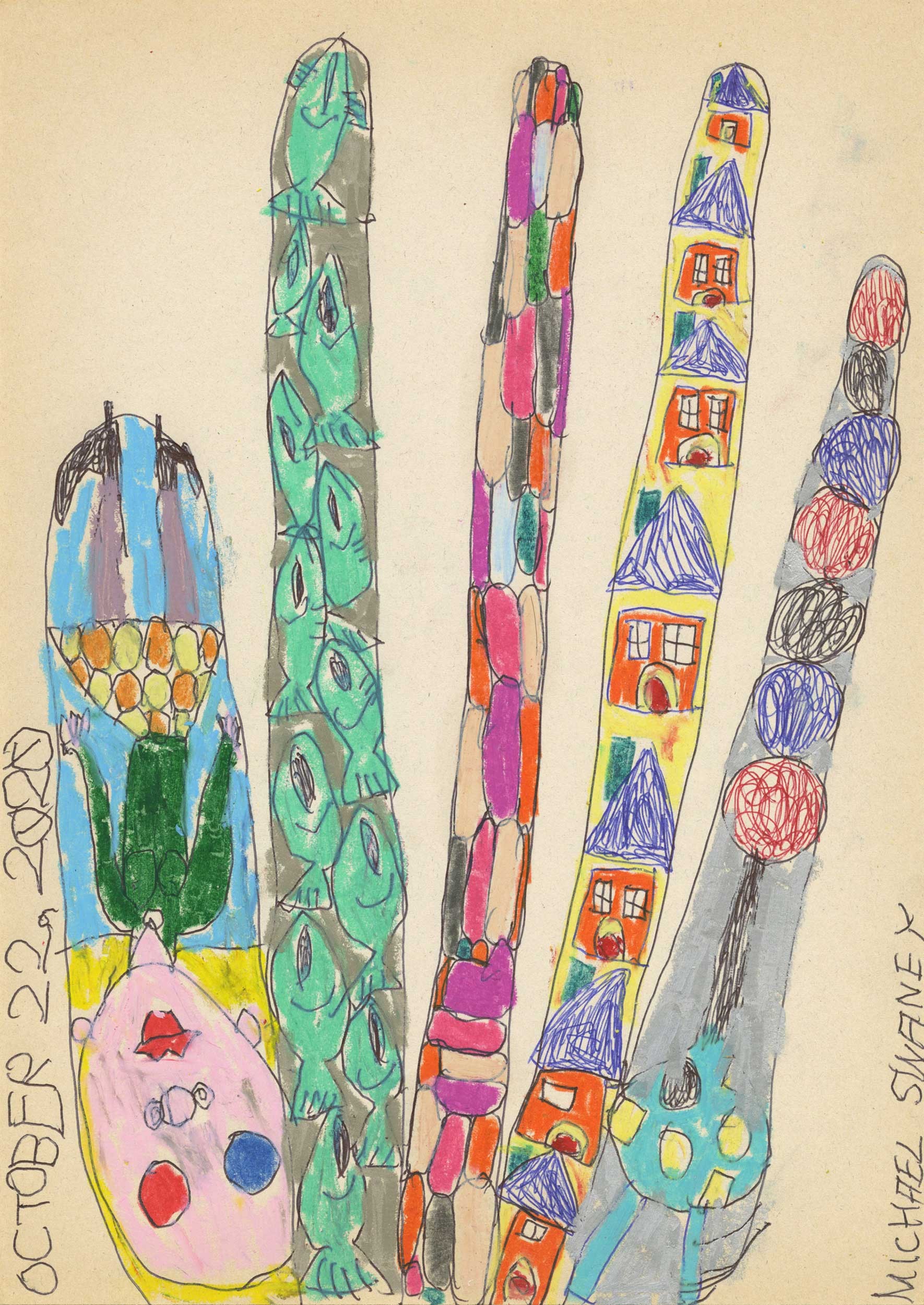
Hamsa Finger Family (3), 2020, 21 × 29,7 cm, oil pastel and ballpoint pen on paper, © courtesy Michael Swaney and Bomma
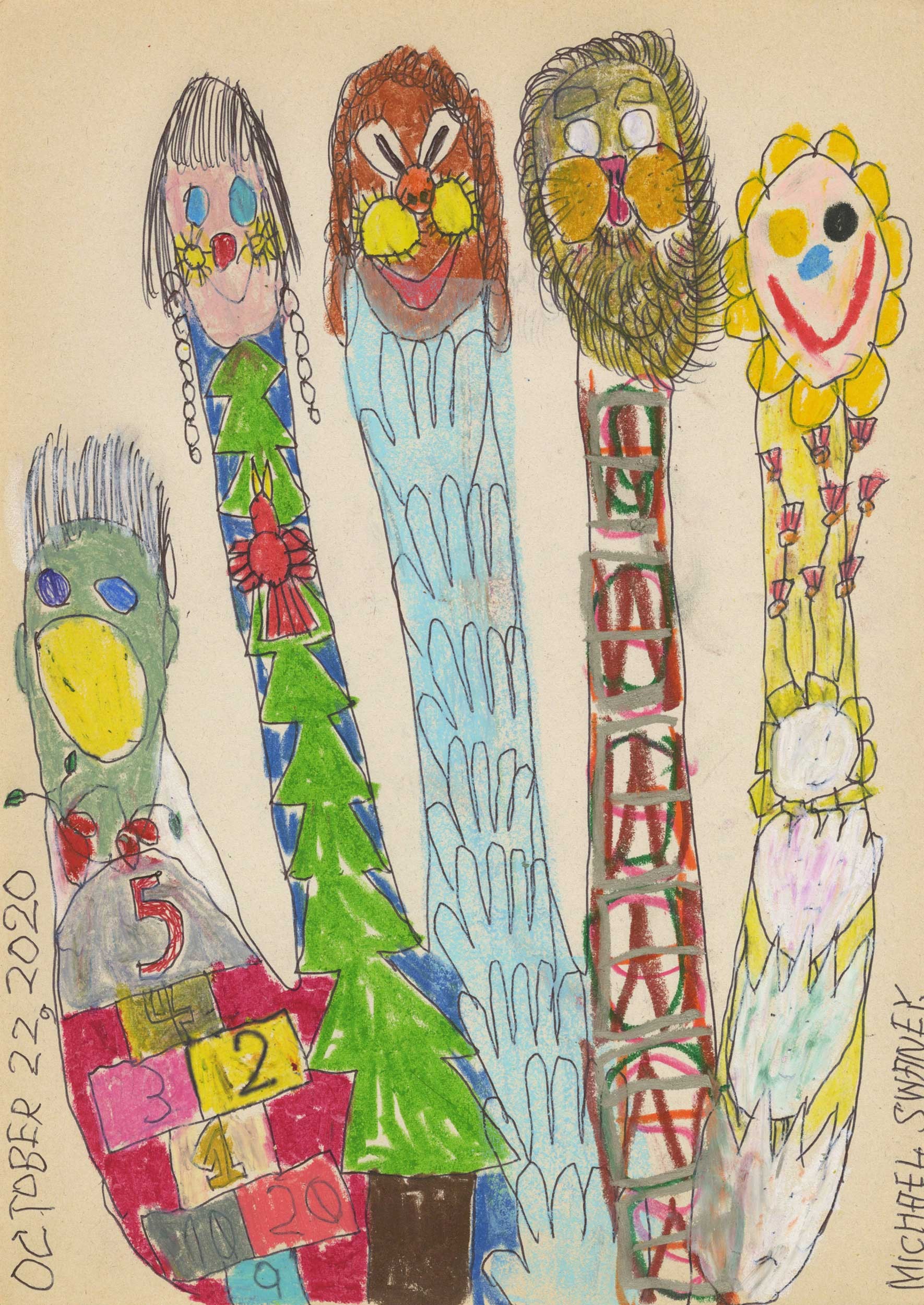
Hamsa Finger Family (2), 2020, 21 × 29,7 cm, oil pastel and ballpoint pen on paper, © courtesy Michael Swaney and Bomma
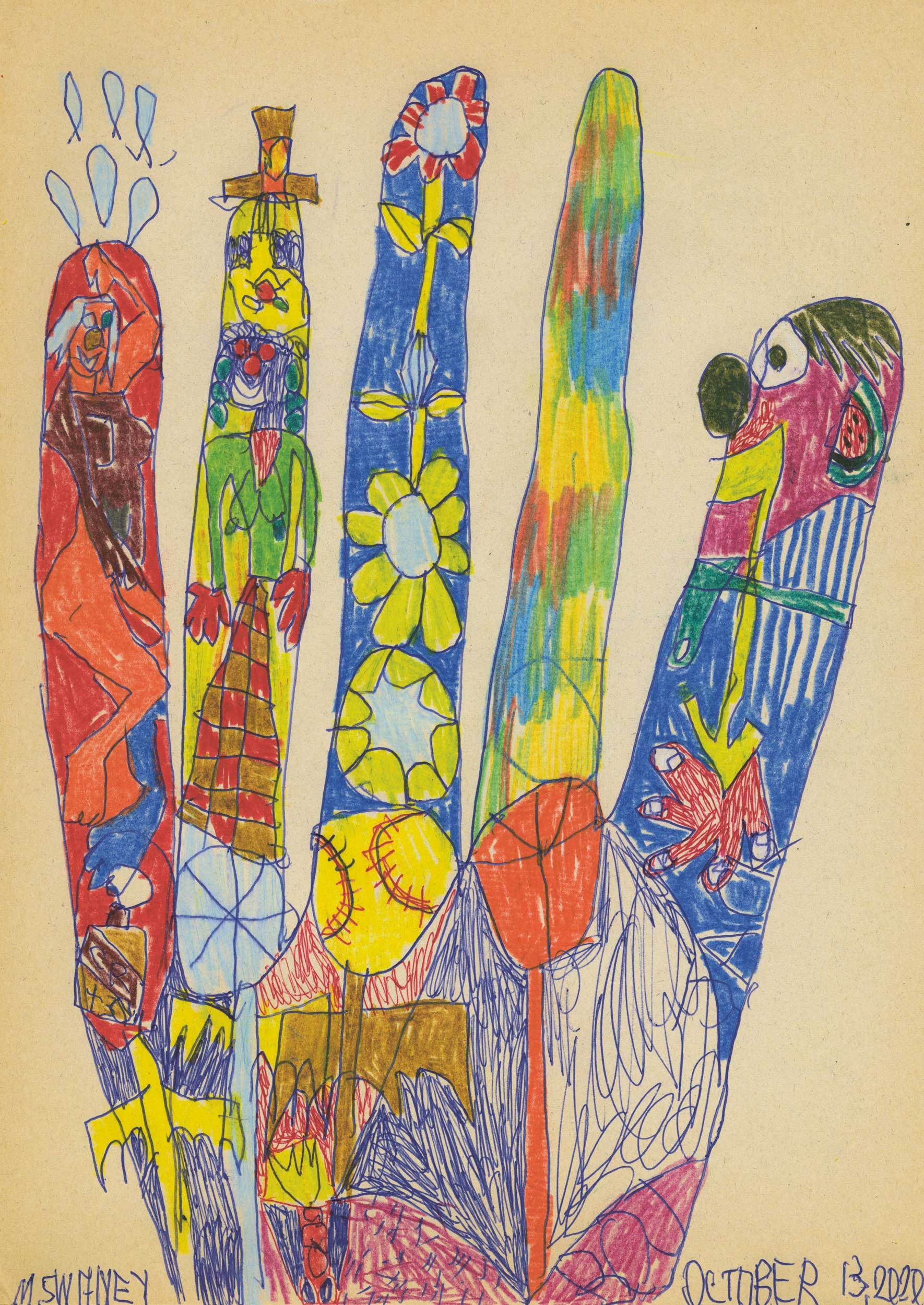
Hamsa Finger Family (5), 2020, 21 × 29,7 cm, oil pastel and ballpoint pen on paper, © courtesy Michael Swaney and Bomma
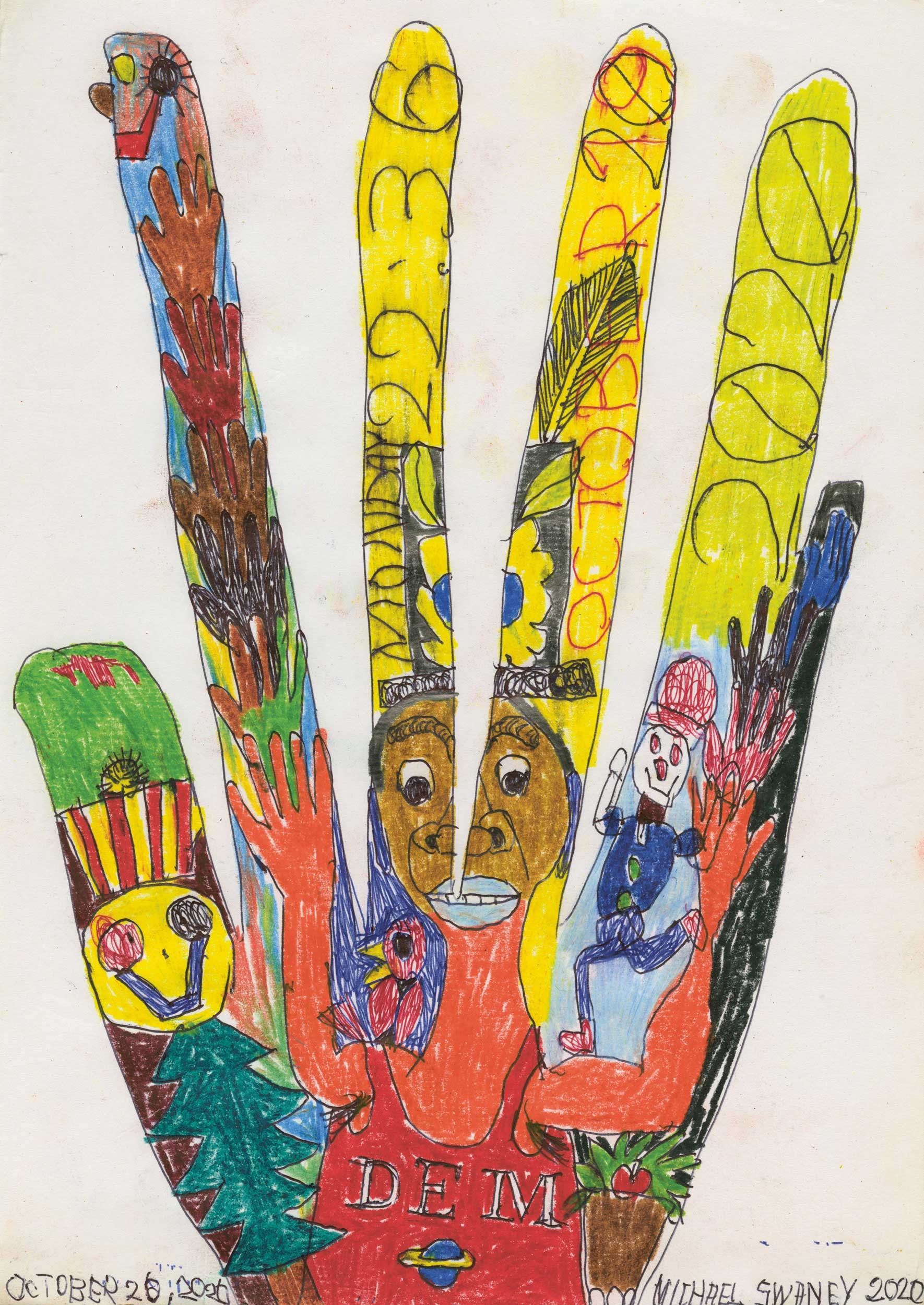
Hamsa Finger Family (4), 2020, 21 × 29,7 cm, oil pastel and ballpoint pen on paper, © courtesy Michael Swaney and Bomma

Finger Family, Black and White Hand, Michael Swaney, 2019, ink on paper, 28 × 21,5 cm, © courtesy Michael Swaney
Dear readers, it is a great pleasure to present this new interview format, an opportunity to open a window on artists studios, to give us more material to read and understand about their creations who fascinate and captivate us. I am honored to open this serie with Michael Swaney. Let yourself be immersed in his world and share a piece of his reflection.
Do you have any first memory of drawing or painting?
I can remember often collaboratively drawing with friends as a kid. Laying out large poster paper on the floor and working on cross-sectioned worlds inside of a mountain or under the ocean with secret chambers and tunnels, like an ant farm or animal borough. I’d do comic strips and imaginary monsters, robots, animals, and I also have fond memories of making cut-out sea creatures with my Gramma in Canada which we would then lay out on the living room floor and we named it, “The Ocean”. I still have all of those drawings saved in a box.
Are there exhibitions or artworks that have left their mark on you when you were a child?
I remember seeing my Mom’s art all the time when I was young. She was always doing these black and white charcoal / pastel portraits on velvet-like paper. We lived in a small Bavarian themed town in the Rocky Mountains so there wasn’t much art around, aside from the decorated fire hydrants, wooden bridges and the town mascot that was a massive Bavarian man with two pints in his hands. He was called Happy Hans. I also remember going to a cultural center where my Mum took drawing classes.
You once told me that the “indigenous art” of British Columbia have had a big influence on your work, How did it affect you?
Yes, on the west coast of Canada I grew up seeing a lot of indigenous art such as totem poles, carved objects and jewellery and it’s left a strong, lasting impression on me. I love the bold color palette and the natural imagery that it utilises.
You are now living in Barcelona, you mentioned the Mosaic and Gaudi (Make the Worst Possible Joke about Yourself, Benjamin Murphy & Michael Swaney), the way the storefronts were held, the blinds you took pictures of… Did moving to Barcelona gave you new artistic perspectives? How does the place you live in influence your practice?
I’m a huge fan of Hundertwasser, and he was a fan of Gaudi, so it was only a logical step for me to eventually appreciate Gaudi’s work too. Living close to his buildings and mosaics has been a privilege. It was first Hundertwasser who lead me to doing mosaics in 2006 when I was still living in Canada.
Barcelona is a relaxing place to live and make work, and it’s usually sunny so it can make it hard sometimes to want to stay inside and work. It’s also such a tourist hub that there are always artists from around the world coming through all year round, and I love meeting up with these friends for studio visits and a bite to eat. People say that it seems living in the Mediterranean has affected my use of color, but I think it’s more a case of my use of color makes sense within this environment.
You take a lot of pictures of places you visit or of your daily life. What kind of pictures did you take when you came to Paris?
Yes I’ve always shot on film and several years ago began to organise them into categories: Found art, kids art, pattern, outsider / marginal creations, botched-job art, etc. I’m constantly looking for evidence of the human hand in nature and within the city; subtle creative efforts, whether intentional or unintentional. In Paris I took a lot of photos at Halle Saint Pierre and at the amazing molder’s studio that you took me to. Also some nice hand painted lettering from around the city.
Does your design education had any influence on the way you work?
I’m sure it has in some ways but don’t think it’s much worth mentioning. It was coupled by illustration education as well and I focused more on that side. Design training could have influenced my tendency to organise and arrange elements in paintings in blocks and grids etc, but maybe that’s just naturally the way I work.
Does that mean that you are a self-taught artist? What does this mean to you?
The self taught, Outsider, Art Brut, Naive, etc. categories are prestigious in my opinion, and pertain to artists who I respect so much, and who deserve those unique labels. Their incorrect use can be misleading and omits the work done by people like Jean Dubuffet and Roger Cardinal. I first learned how to draw from my Mum, and then later at high school and University / College. I think these categories are ok to maintain so as to give marginal creators a dignifying and authentic title.
In an interview for Delphian Gallery (Benjamin Murphy & Michael Swaney), you talked about your father’s anti-deer arrangement. Can you describe what that looked like?
They look like zig-zagged stacks of lumber that are precariously arranged across stairwells or around fruit trees in order to keep animals away.
It was much later that you realized, as you said, that it was a form of artistic expression. When did you start to notice these artistics non-intentions?
I started to see these types of home fixes as artistic expression. From scarecrows, to garden post labelling systems, to bathroom hanger display boards in shops or anti- pigeon gadgets. My Dad has always been leaving behind these kinds of unintentional artistic expressions which I began to call “chapuza art” or botched job art.
You were a member of the Humanfive collective: four artists working on the same works. How do you feel about working with other artists now that you work alone?
What we had with Humanfive was extremely special and unique, unlike anything I’ve experienced since then. The ego was detached and we trusted one another with each step in the process. I love to work with people in general but lately I prefer to work with people who have little artistic training, as I try to do with my mosaic projects.
It happens that you collaborate with different audiences for mosaic murals for example. What do you get out of those experiences?
It’s extremely fulfilling to give these participants some creative freedom during the process and to see the surprising results. I’ve collaborated with people ranging in age from 5-90 years old and always learn something from them. In Los Angeles at Simcor I collaborated with artists from the Tierra del Sol center and it was amazing.
In what ways does your work reflect your forms of commitment, political or environmental?
In terms of environmental action, I’ve always tried to act responsibly with my use of materials in that I’m constantly salvaging them from different places and second hand shops, and try my best to throw away as little as possible. When I do the mosaic projects I encourage the neighbours and participants to bring along their own discarded and broken ceramics to be included. I don’t focus too much on political themes in my work and would rather discuss humanitarian themes but even so, they aren’t often direct or obvious references. My work is more centered around nature, the animal kingdom and humanity.
What does it mean to be on a parallel path with Art Brut (Interview by Theresa Crespi, Metal Magazine)?
This is something I came up with some years back to try to express how I feel about my way of making art. I do paintings because I feel the need to, and it is undoubtedly a form of therapy. In saying that, Art Brut creators created work out of necessity and repetition, while using materials they had within their arms reach and economical means, while at the same time taking zero consideration for an audience or market. I don’t think of an idea for weeks and then begin, or consider the market before doing a painting. I work in constant repetition, often losing myself in the use of material and color in a hypnotic-like state. After repeating the process many times I start to see what it is that I’m doing, and meaning comes out of that.
You often dedicate your works to the pillars of this movement, what does this mean for you?
Lately I’ve been incorporating the names of black Folk Artists from the American south in my Finger Family paintings; one per painting, as homages. It’s been too long now that these artists haven’t been credited for what they’ve done, and of course it’s been from racial discrimination. Many artists over the years has taken inspiration from them and even appropriated their ideas without due credit and it’s time for us to stop omitting that from Art History in an even bigger way. Yes of course, Outsider Art is bigger than ever now and reaching for beyond what its founders could have ever imagined. But there is far more work to be done to properly document the lives and works of these people who’ve brought some of the richest, most authentic bodies of work to our world. Aloïse Corbaz is my Picasso.
I would like you to tell us about your relationship with the art market and its actors, galleries, institutions and collectors: what guides your choices?
Once you begin to sell works, there’s an undeniable relationship to the market. The thing I like least about the market might be the fact that it assimilates change in an artist’s practice so slowly. When I need to try something new I’m guided mostly by intuition and do it without thinking about the market or the repercussions. Occasionally you get to converse with the collectors who buy the work, but it’s not that seldom unfortunately. It would be great to get to know the people who are appreciating what I do.
You are a serial worker. Your obsession for hands intrigues a lot of people, some even think you’d be some kind of fetishist. Do you have to be a little obsessive when you work in series?
I definitely don’t have a hand fetish though I do like them. Yes, repetition requires a degree of obsession, but also I wouldn’t keep doing them if I was bored or uninspired.
Besides, how does a series end? What would make you stop drawing hands?
I can’t be sure when, but at this point it seems like a limitless subject matter still.
Sometimes series are porous (hands and perfume together on Givenchy, Colors, Fendi, Swaney (30th Hand), 2020) why did they meet?
It was a fun way to link these two disparate series. A crudely painted, seemingly superficial, “photo-realist” series with an imaginative, down to earth, painterly series.
How did the Hamsa Finger Family project start?
Bronze sculpture has fascinated me for years now so when you contacted me to do the project I was immediately attracted to the idea. I first made a life-sized sculpture in clay which was then shipped to Paris to begin the molding process.
What is the meaning of this bronze hand?
I knew that the hand represented different things in different religions and cultures across the world, and liked that it protected people from the evil eye, or just evil in general. So after researching a bit more I learned about the word hamsa, and liked it a lot. It represents blessings, power and strength. I feel like this is a good luck charm that can truly protect those who own one.
If you had to divide your career into several periods, what would they be?
2000-2007: Paintings and installations made with mostly salvaged objects with the art collective, Humanfive. 2007-2012: Collage / mixed media work on paper and paper mâché / assemblage sculptures. 2012-Current: Paintings, drawings, ceramic sculpture and mosaics.
You just moved to a new studio, does it imply new projects?
I’m almost there and yes, it implies expansion on all levels. I will have a painting area, a ceramic area and a mosaic area in order to separate practices and be able to flow freely between each one.
How do you work in your workshop, what are your routines?
Up until now, and since my daughter was born, I’ve been working 4 hour intervals per day, and rarely on weekends. I usually arrive the studio and have a coffee, and then get straight to work without much delay, always listening to music or podcasts.
You claim an accessible art: what’s important to you: the accessibility of the practice, the acquisition process or the larger understanding of a work?
Elitism is what takes away the beauty in contemporary art for me. The whole process of getting to know the artist, acquiring work, and understanding the work should be more accessible and relaxed. If there was always an attempt to communicate in a simple way through texts, there would never be any problem in understanding the art or excluding anybody.
As an amateur and collector, can you share one of your recent discoveries?
I always buy art from people who sell it on the street and have been buying from a woman named Veronica the past few years. She does these beautiful little marker and crayon drawings on A4, sometimes A3 paper.
Your work is often associated with the terms “childish”, “naive”, how do you feel about those words?
I can understand why my work is described like that, but wish there was some different vocabulary to explain it. I have loved and collected kids art since I was in high school. I’m not trying to do big kids paintings and know there is a psychological dimension to the paintings that makes that clear. I believe I’ve retained an image bank from when I was a kid, and can access those images and ways of drawing things still to this day.
Wouldn’t it be a bit like building a myth to systematically associate childhood with imagination, purity, spontaneity? As if it were pure creation?
Well, it is the way that many grown artists view it. Kids are influenced by popular culture instantly so in that sense the subject matter is “tainted” from day one. But it is still pure creation that’s unaffected by the market, an audience and the general rules of art making.
How do you approach these creations?
I admire them and document whenever possible. I think it is an incredibly positive sign in a family when kids art is given value and a protagonist role within their living space. We have to encourage kids to keep creating no matter how it comes out and always delineate that it doesn’t have to be perfect or coloured within the lines. Discouraging kids while making art is a massive error that may often be irreversible even at a young age.


